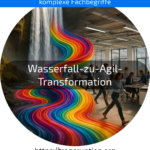The term waterfall-to-agile transformation originates from the areas of digital transformation, HR work and teams as well as Industry and Factory 4.0, where it describes the transition from traditional, rigid working methods (waterfall) to flexible, fast methods (agile) in companies.
In the waterfall model, a team works strictly according to a plan and all tasks are carried out step by step. Changes are hardly possible during the process. The agile way of working, on the other hand, relies on regular coordination within the team, rapid reactions to new requirements and continuous improvements.
An illustrative example: A company develops software for machines. Previously, all the requirement lists were created first, then programmed and the result presented at the end. It was almost impossible to make changes during development. With the waterfall-to-agile transformation, the team now works in short work phases, known as sprints. After each sprint, customer feedback and new findings can flow directly into the next work package.
The waterfall-to-agile transformation not only promotes more flexible projects, but also increases employee motivation and customer satisfaction - a crucial step for companies that want to remain successful in the digital world.






